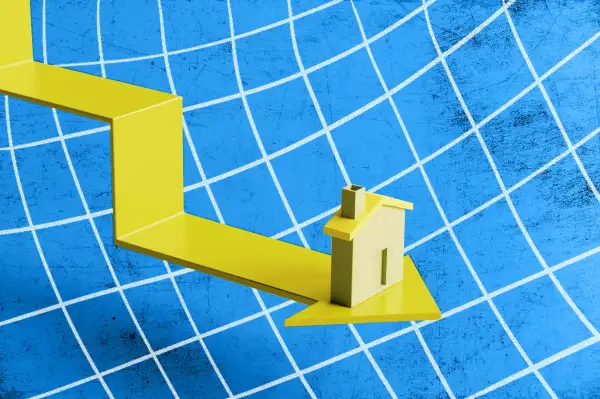Mortgage Rates Will Drop Below 6% This Year, Says Fannie Mae

Homebuyers could be in line for a big break by the end of the year as mortgage rates are expected to dip under 6% for the first time since September 2022.
A recent report from Fannie Mae, a government-sponsored enterprise that purchases home loans from mortgage lenders, is predicting that mortgage rates will begin a slow, if somewhat bumpy, descent from their current levels in the mid-6% range. The rate on a 30-year fixed-rate loan is forecast to average 5.8% by the end of the year. Some other recent mortgage rate predictions, meanwhile, are saying that rates will stay above 6% this year.
Rates have already decreased by more than a percentage point since last October. If Fannie Mae’s current prediction comes true, the rate will have gone down by almost two percentage points from its 2023 high of 7.79% — a change that will have an increasingly significant impact over time for homebuyers and sellers.
Fannie Mae’s rate new forecast is slightly more optimistic than its previous ones because the Federal Reserve recently signaled a “pivot” in its monetary policy, says Doug Duncan, Fannie Mae’s chief economist. The Fed is switching from its rate-tightening policy toward a sustained pause and eventual decrease in the federal funds rate, which will likely nudge mortgage rates lower.
But don’t expect rates to follow a straight line down. There are many factors, such as an expansion of fighting in the Middle East, that could create supply issues and cause economic conditions, including inflation, to reverse course, which could in turn cause the Fed to adjust its plans to cut rates.
Plus, mortgage rates are influenced by the bond market, which reacts to every new tidbit of economic news, from the unemployment rate to retail sales. As a result, says Mark Palim, vice president and deputy chief economist at Fannie Mae, “It’s going to continue to be that kind of week-to-week movement” we’ve recently had, with hard-to-predict mortgage rate fluctuations during any given moment.
Housing market conditions should slowly improve
The housing market has been out of whack since before the pandemic. Duncan says the rules of thumb that typically apply to the housing market have been distorted, first by the aftermath of the Great Recession and then by the buying frenzy that occurred during the COVID-19 shutdowns.
The dramatic shift in the number of homes sold in recent years is one clear indication of how strange the housing market has been. During a typical year with balanced sales volume, around five million homes would be sold. Yet 2021 was an outlier, with over six million homes sold, and 2023 saw total home sales plummet to less than four million.
Duncan expects home sales to recover this year as the housing market returns to a more typical pattern, largely due to a decrease in mortgage rates.
Lower rates lead to lower monthly payments and improved affordability, attracting more potential buyers who can finally buy a home. Fannie Mae is now forecasting that there will be around 4.5 million home sales by the end of the year.
The recent drop in rates has also already spurred an uptick in mortgage refinancing, which dropped to 20-year lows in 2023. As rates keep decreasing, more homeowners will see the wisdom of swapping out their high-interest-rate loans for better terms.
Where housing inventory and home prices are heading
Housing inventory has also been a challenge for homebuyers since there hasn’t been enough supply to satisfy demand, but the road to recovery in this sector will take a lot longer.
Housing supply has been running low since the end of the 2008 market crash, as the glut of foreclosed properties caused a lull in new construction. Even as the market recovered, builders were gun shy about new construction, fearing they would be stuck with a large number of unsold homes, so they scaled back the number of new builds.
As a result, inventory was low when the pandemic boom hit, exacerbating the shortage of available homes for sale. Current inventory is running at about a 3-month supply, which is way too low to keep up with “normal” demand.
Low inventory levels don’t “give buyers the opportunity to carefully look at a bunch of properties,” says Palim. “They have to worry about the multiple offers, and that doesn’t seem terribly healthy.”
Lower rates are unlikely to meaningfully improve the situation. Some homeowners have started to come back to the market and list their houses for sale, which has led to a slight improvement in available supply. But those who have mortgages in the 3% and 4% range are unlikely to sell, especially if they have to buy another property at a much higher rate, which means the market will still be short on existing homes for sale.
Because demand is likely to continue to outpace supply, home prices are expected to increase, but at a slower pace compared to the recent boom years. Fannie Mae expects home prices to increase by 3.2% in 2024, compared to 7.1% in 2023.
More from Money:
Best Mortgage Lenders of January 2024
Best Mortgage Refinance Companies of 2024
Here’s Where Mortgage Rates and Home Prices Are Heading, According to Zillow and Redfin

